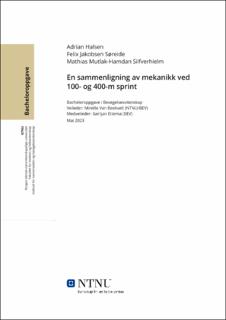| dc.contributor.advisor | Van Beekvelt, Mireille | |
| dc.contributor.advisor | Ettema, Gertjan | |
| dc.contributor.author | Halsen, Adrian | |
| dc.contributor.author | Søreide, Felix Jakobsen | |
| dc.contributor.author | Silfverhielm, Mathias Mutlak-Hamdan | |
| dc.date.accessioned | 2023-07-05T17:20:29Z | |
| dc.date.available | 2023-07-05T17:20:29Z | |
| dc.date.issued | 2023 | |
| dc.identifier | no.ntnu:inspera:146716277:148837633 | |
| dc.identifier.uri | https://hdl.handle.net/11250/3076335 | |
| dc.description.abstract | Abstrakt
Formålet med studiet
Denne studien tar sikte på å sammenligne mekanikken i 100-meter og 400-meter sprint ved å undersøke ulike mekaniske variabler.
Metode
Det ble gjennomført et litteratursøk ved bruk av Scopus-databasen, og åtte originale studier ble inkludert. Studiene analyserte mekaniske variabler innen 100- og 400-m og deres korrelasjon med prestasjon innen sprint.
Resultat
Resultatene viste at de som løp 100-meter presterte bedre enn de som løp 400-meter på alle mekaniske variabler. Den eneste variabelen hvor 100-m ikke presterte bedre enn 400-m var lufttid. Totalt sett viste 100-meter sprintere bedre mekanisk ytelse sammenlignet med 400-meter sprintere. Basert på funnene utført i denne studien antas det at de mekaniske forskjellene skyldes de ulike fysiologiske systemene som tas i bruk.
Konklusjon
Studien viser bedre mekanisk prestasjon ved 100-m enn 400-m. Det blir understreket viktigheten av å vurdere mekaniske faktorer i sprintprestasjon ved både 100- og 400-m. Samt må tempostrategi bli tatt hensyn til i et 400-m løp. Til slutt må det poengteres at studien har blitt begrenset av manglende forskning innen det relevante feltet. | |
| dc.description.abstract | Abstract
Purpose of the study
This study aims to compare the mechanics of the 100-meter and 400-meter sprints by examining various mechanical variables.
Method
A literature search was conducted using the Scopus database, and eight original studies were included. The studies analyzed mechanical variables within 100- and 400-m and their correlation with sprint performance.
Results
The results showed that the subjects who ran 100-m performed better than those who ran 400-m in all mechanical variables. The only variable where 100-m did not outperform 400-m was aerial time. Overall, 100-m sprinters demonstrated better mechanical performance compared to 400-m sprinters. Based on the findings of this study, it is assumed that the mechanical differences are due to the different physiological systems involved.
Conclusion
The study demonstrates better mechanical performance in the 100-m sprint compared to the 400-m sprint. It emphasizes the importance of considering mechanical factors in sprint performance for both the 100- and 400-m sprints. Additionally, it highlights the need to consider pacing strategy in a 400-m race. Finally, it should be noted that the study has been limited due to the lack of research within the relevant field. | |
| dc.language | nob | |
| dc.publisher | NTNU | |
| dc.title | En sammenligning av mekanikk ved 100- og 400-m sprint | |
| dc.type | Bachelor thesis | |
